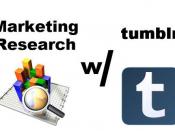Introduction
There has never been a tougher time to run a business. Confronted with this dynamic atmosphere companies today are discovering the importance of maximizing the value of information provided by research. Companies that transform information into a competitive asset can turn even the toughest challenges into opportunities. Capitalizing on the information a company owns about its business processes, employees, customers, suppliers and partners is the new competitive edge, as it will act as capital that earns high returns. Information gathered through research will help organizations to understand their employees and customers instead of just processing them, optimize relationships with suppliers instead of just buying from them and align the organization for the future instead of waiting to react. Information acts as the new value proposition for sustainable long term growth.
Data collected and subsequently processed, turns into information. There are a number of techniques available for collecting business data.
One such technique is observation research. Observation offers researchers a distinct way of collecting data. As well as asking people what they do and want they think, observation research looks at what people actually do. Observation research recognizes the fact that information is held in the behaviour of people. Information gathered through observation research enable decision makes to yield useful hypothesis about employee/consumer behaviour.
Observation research encompasses the gathering of primary data by observing relevant people, actions and situations. It is a non-verbal means of obtaining primary data. Observing how people actually work or how consumers actually behave can point decision makers in directions that pure market data would not necessarily do.
Literature Review
Dimensions of Observational Techniques
Natural
Vs. Contrived Natural
Observing behaviour as it occurs normally in the environment. The observation scenario is not created.
Contrived
Observing behaviour in an artificial environment. The researcher sets the scenario.
Disguised
Vs. Undisguised Disguised
The people being observed are not aware that they are being observed. Undisguised
The subjects are aware that they are being observed.
Structures Vs. Unstructured Structured
The approach to be followed is specified in detail including what behaviours are to be observed. The study is pre-determined. Unstructured
The approach is not specified and the behaviour to be observed is not precisely defined. Observers record all aspects of behaviour.
Direct
Vs.
Indirect Direct
Behaviour is observed as it occurs. Indirect
Record of past behaviour
Human
Vs. Mechanical Human
Human observers are used. Mechanical
Mechanical devices are used in observing behaviour.
(Source : Adapted from T.C. Kinnear and J.R. Taylor, Marketing Research, 3rd ed. New York : McGraw-Hill, 1987. pg 398-400)
Direct Observation
Direct observation of people and how they behave in situations of interest is a commonly used method of collecting information. Direct observation can be divided into two categories:
1. Participant observation
2. Non-participant observation
Participant observation as the name implies, is a form of observation in which the observer actually participates in the activities of the group he or she wishes to study.
Non-participant observation in contrast, are non-reactive measures. This is also referred to as unobtrusive observation, where to observer does not participate in the activities of the group. The behaviour is observed remotely.
Strengths of Observation Research
It is not dependent on the respondents memory as it records exactly what has happened and not what the respondent believes has happened.
Observation may be the least expensive and most accurate method of collecting purely behavioural data.
In certain circumstances, observation may be the only alternative for collecting data. For example, young children cannot articulate their preferences or motives.
The potential bias is reduced as the researcher witnesses behaviour, rather than asking questions, which may influence the responses of respondents.
When questioning respondents, certain facts may be withheld from the interviewer. Respondents often cannot and sometimes will not report information accurately. This can be eliminated with the use of observation research.
Observation can counter the high refusal rates in some markets.
Research conducted by way of observation does not interfere with the respondents day to day life.


